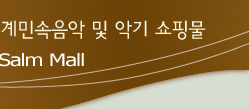|
|
 |
|
|
 |
|
CH-Ruan (루안)
2000천년 역사의 중국악기로 전해지며 7세기 둔황 동굴 벽화에서도 모습을 볼 수 있는데, 대중소 크리로 나누어지며 이 제품은 소(Xiao) 류안이다. 소리는 기타와 비슷하며, 아름답고 부드러운 음색을 낸다.
- 사이즈 : 10 * 31 * 72 cm
- 케이스 포함
Ruan
The ruan is often called the Chinese "moon guitar" due to its round body, and is one of a family of round body instruments that are found in both classical and folk music. The excact age of the ruan is unknown, but it is known to have at least two thousand years of history, and that it is native to China. There are many depictions of the ruan in depictions of court orchestras painted on the walls of caves in DunHuang, that date from the 7th Century and before.
The ruan is found in three sizes: the small xiao-ruan, the middle sized ruan and the bass da-ruan. Common tunings are gdae or adad for the ruan and bfcg, cgda, or cgcg for the da-ruan.
The ruan has a beautiful mellow tone that is very similar to that of the guitar
|
|
|
|
|
* 배송료
안내- 5만원 이상은
무료, 5만원
미만은 배송료(제주도 등 도서지방 제외) 4,000원 |
|
|
|
|




 [소리삶] 대표: 이영진
[소리삶] 대표: 이영진 주소 : 경기도 파주시 탄현면 헤이리마을길 63-26 Tel : 031)946-9810 Fax : 031)946-9812
주소 : 경기도 파주시 탄현면 헤이리마을길 63-26 Tel : 031)946-9810 Fax : 031)946-9812 사업자 등록번호 128-19-90855
사업자 등록번호 128-19-90855  통신판매업 허가번호 : 고양시 제 55호
통신판매업 허가번호 : 고양시 제 55호
